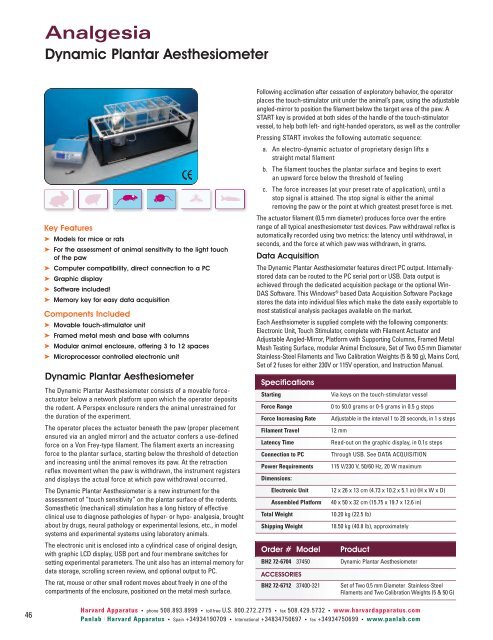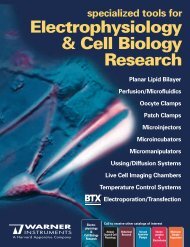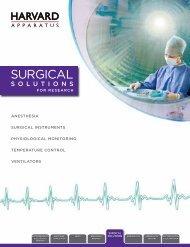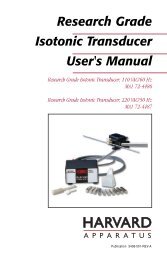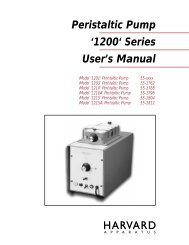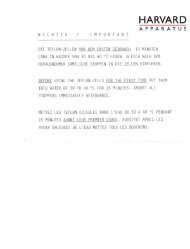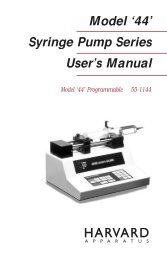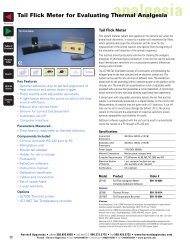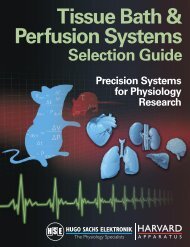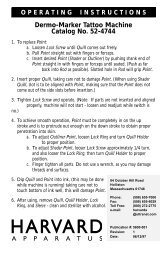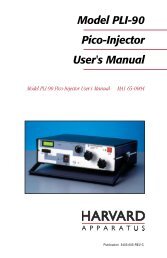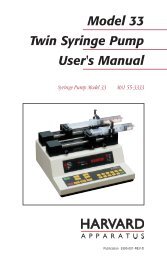View Catalog PDF - Harvard Apparatus
View Catalog PDF - Harvard Apparatus
View Catalog PDF - Harvard Apparatus
You also want an ePaper? Increase the reach of your titles
YUMPU automatically turns print PDFs into web optimized ePapers that Google loves.
Analgesia<br />
Dynamic Plantar Aesthesiometer<br />
Key Features<br />
➤ Models for mice or rats<br />
➤ For the assessment of animal sensitivity to the light touch<br />
of the paw<br />
➤ Computer compatibility, direct connection to a PC<br />
➤ Graphic display<br />
➤ Software included!<br />
➤ Memory key for easy data acquisition<br />
Components Included<br />
➤ Movable touch-stimulator unit<br />
➤ Framed metal mesh and base with columns<br />
➤ Modular animal enclosure, offering 3 to 12 spaces<br />
➤ Microprocessor controlled electronic unit<br />
Dynamic Plantar Aesthesiometer<br />
The Dynamic Plantar Aesthesiometer consists of a movable forceactuator<br />
below a network platform upon which the operator deposits<br />
the rodent. A Perspex enclosure renders the animal unrestrained for<br />
the duration of the experiment.<br />
The operator places the actuator beneath the paw (proper placement<br />
ensured via an angled mirror) and the actuator confers a use-defined<br />
force on a Von Frey-type filament. The filament exerts an increasing<br />
force to the plantar surface, starting below the threshold of detection<br />
and increasing until the animal removes its paw. At the retraction<br />
reflex movement when the paw is withdrawn, the instrument registers<br />
and displays the actual force at which paw withdrawal occurred.<br />
The Dynamic Plantar Aesthesiometer is a new instrument for the<br />
assessment of “touch sensitivity” on the plantar surface of the rodents.<br />
Somesthetic (mechanical) stimulation has a long history of effective<br />
clinical use to diagnose pathologies of hyper- or hypo- analgesia, brought<br />
about by drugs, neural pathology or experimental lesions, etc., in model<br />
systems and experimental systems using laboratory animals.<br />
The electronic unit is enclosed into a cylindrical case of original design,<br />
with graphic LCD display, USB port and four membrane switches for<br />
setting experimental parameters. The unit also has an internal memory for<br />
data storage, scrolling screen review, and optional output to PC.<br />
The rat, mouse or other small rodent moves about freely in one of the<br />
compartments of the enclosure, positioned on the metal mesh surface.<br />
Following acclimation after cessation of exploratory behavior, the operator<br />
places the touch-stimulator unit under the animal’s paw, using the adjustable<br />
angled-mirror to position the filament below the target area of the paw. A<br />
START key is provided at both sides of the handle of the touch-stimulator<br />
vessel, to help both left- and right-handed operators, as well as the controller<br />
Pressing START invokes the following automatic sequence:<br />
a. An electro-dynamic actuator of proprietary design lifts a<br />
straight metal filament<br />
b. The filament touches the plantar surface and begins to exert<br />
an upward force below the threshold of feeling<br />
c. The force increases (at your preset rate of application), until a<br />
stop signal is attained. The stop signal is either the animal<br />
removing the paw or the point at which greatest preset force is met.<br />
The actuator filament (0.5 mm diameter) produces force over the entire<br />
range of all typical anesthesiometer test devices. Paw withdrawal reflex is<br />
automatically recorded using two metrics: the latency until withdrawal, in<br />
seconds, and the force at which paw was withdrawn, in grams.<br />
Data Acquisition<br />
The Dynamic Plantar Aesthesiometer features direct PC output. Internallystored<br />
data can be routed to the PC serial port or USB. Data output is<br />
achieved through the dedicated acquisition package or the optional Win-<br />
DAS Software. This Windows ® based Data Acquisition Software Package<br />
stores the data into individual files which make the date easily exportable to<br />
most statistical analysis packages available on the market.<br />
Each Aesthsiometer is supplied complete with the following components:<br />
Electronic Unit, Touch Stimulator, complete with Filament Actuator and<br />
Adjustable Angled-Mirror, Platform with Supporting Columns, Framed Metal<br />
Mesh Testing Surface, modular Animal Enclosure, Set of Two 0.5 mm Diameter<br />
Stainless-Steel Filaments and Two Calibration Weights (5 & 50 g), Mains Cord,<br />
Set of 2 fuses for either 230V or 115V operation, and Instruction Manual.<br />
Specifications<br />
Starting<br />
Force Range<br />
Force Increasing Rate<br />
Filament Travel<br />
Latency Time<br />
Connection to PC<br />
Power Requirements<br />
Dimensions:<br />
Via keys on the touch-stimulator vessel<br />
0 to 50.0 grams or 0-5 grams in 0.5 g steps<br />
Adjustable in the interval 1 to 20 seconds, in 1 s steps<br />
12 mm<br />
Read-out on the graphic display, in 0.1s steps<br />
Through USB. See DATA ACQUISITION<br />
115 V/230 V, 50/60 Hz, 20 W maximum<br />
Electronic Unit 12 x 26 x 13 cm (4.73 x 10.2 x 5.1 in) (H x W x D)<br />
Assembled Platform<br />
Total Weight<br />
Shipping Weight<br />
Order # Model<br />
40 x 50 x 32 cm (15.75 x 19.7 x 12.6 in)<br />
10.20 kg (22.5 lb)<br />
18.50 kg (40.8 lb), approximately<br />
Product<br />
BH2 72-6704 37450 Dynamic Plantar Aesthesiometer<br />
ACCESSORIES<br />
BH2 72-6712 37400-321 Set of Two 0.5 mm Diameter Stainless-Steel<br />
Filaments and Two Calibration Weights (5 & 50 G)<br />
46<br />
<strong>Harvard</strong> <strong>Apparatus</strong> • phone 508.893.8999 • toll free U.S. 800.272.2775 • fax 508.429.5732 • www.harvardapparatus.com<br />
Panlab | <strong>Harvard</strong> <strong>Apparatus</strong> • Spain +34934190709 • International +34834750697 • fax +34934750699 • www.panlab.com


